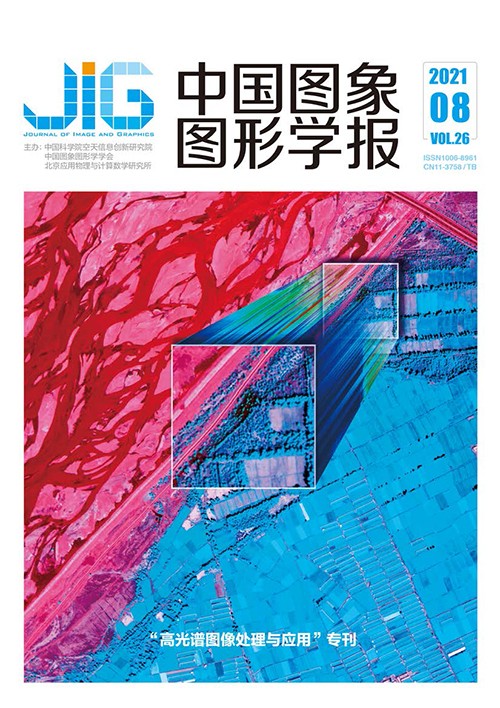
高光谱图像小样本分类的卷积神经网络方法
摘 要
目的 与传统分类方法相比,基于深度学习的高光谱图像分类方法能够提取出高光谱图像更深层次的特征。针对现有深度学习的分类方法网络结构简单、特征提取不够充分的问题,提出一种堆叠像元空间变换信息的数据扩充方法,用于解决训练样本不足的问题,并提出一种基于不同尺度的双通道3维卷积神经网络的高光谱图像分类模型,来提取高光谱图像的本质空谱特征。方法 通过对高光谱图像的每一像元及其邻域像元进行旋转、行列变换等操作,丰富中心像元的潜在空间信息,达到数据集扩充的作用。将扩充之后的像素块输入到不同尺度的双通道3维卷积神经网络学习训练集的深层特征,实现更高精度的分类。结果 5次重复实验后取平均的结果表明,在随机选取了10%训练样本并通过8倍数据扩充的情况下,Indian Pines数据集实现了98.34%的总体分类精度,Pavia University数据集总体分类精度达到99.63%,同时对比了不同算法的运行时间,在保证分类精度的前提下,本文算法的运行时间短于对比算法,保证了分类模型的稳定性、高效性。结论 本文提出的基于双通道卷积神经网络的高光谱图像分类模型,既解决了训练样本不足的问题,又综合了高光谱图像的光谱特征和空间特征,提高了高光谱图像的分类精度。
关键词
Convolution neural network method for small-sample classification of hyperspectral images
Wu Honghao1, Wang Liguo1,2, Shi Yao1(1.College of Information and Communications Engineering, Harbin Engineering University, Harbin 150001, China;2.College of Information and Communication Engineering, Dalian Minzu University, Dalian 116600, China) Abstract
Objective Classification is a major research task in hyperspectral remote sensing image processing. Extracting appropriate features from hyperspectral remote sensing images is a prerequisite to ensure the accuracy and effectiveness of classification. Traditional feature extraction methods can only extract single, shallow spectral or spatial features and have difficulty extracting deep spatial-spectral features. This limitation results in poor classification accuracy. Compared with traditional classification methods, hyperspectral image classification method based on deep learning model can extract deeper features of hyperspectral image. However, the existing deep learning methods can classify hyperspectral images but have low classification accuracy because of their simple network structure and insufficient feature extraction. Moreover, the parameters of deep network are hundreds of thousands of millions, which need a large number of labeled training samples and longer time to complete the model training. However, manual annotation of hyperspectral images is a time-consuming and laborious project, and only a few labeled samples can usually be used. Therefore, constructing a depth network model for hyperspectral image classification with a small number of training samples is a key research problem. A data expansion method of stacking pixel spatial transformation information is proposed to address the problems of simple network structure and insufficient feature extraction of existing classification methods based on deep learning. A hyperspectral image classification model based on different scales of dual-channel 3D convolutional neural network is also proposed to extract the essential spatial features of hyperspectral image. Method On the one hand, the stacking space transform information method is used to expand the training samples for solving the problem of insufficient training samples in the process of hyperspectral image classification. On the other hand, the dual-channel convolutional neural network is used, and its overall structure is composed of preprocessing, data expansion, and dual-channel convolutional neural network (DC-CNN). First, the hyperspectral image is preprocessed to transform the pixels into 3×3 and 5×5 pixel blocks containing certain spatial information as the unit to be processed. Then, the unit to be processed uses the data expansion method of stacking spatial transformation information to expand the data. The expanded dataset is transformed into shape to meet the input dimension of dual-channel convolutional neural network. Then, the pixel blocks of different sizes are input into the branch convolution of different scales of DC-CNN, and they are combined with the spatial spectrum features extracted from the two channels for training to improve the generalization ability of the network. The spatial-spectral features of hyperspectral images can be more comprehensively and fully extracted using different convolution branches to process different sizes of pixel blocks. The information loss caused by dimension reduction can be reduced, and the classification accuracy can be improved. The method of stack space transform information enriches the potential space information of the center pixel and expands the dataset by rotating each pixel and its adjacent pixels, row column transform, and other operations. The expanded pixel blocks are input into dual-channel 3D convolutional neural networks with different scales to learn the deep features of the training set and achieve higher accuracy classification. Three popular hyperspectral image classification methods are selected and compared with this method to verify its effectiveness. The three methods are 2D convolutional neural network (2D-CNN), 3D convolutional neural network (3D-CNN), and siamese neural network (SNN). The network structure of 3D-CNN is the same as that of 3×3 branches of DC-CNN, which can be considered a single-channel network model of DC-CNN. Result Experimental results show that the Indian Pines and Pavia University datasets achieve 98.34% and 99.63% of the overall classification accuracy, respectively. The running time of different algorithms is also compared. The running time of the proposed algorithm is relatively shorter than that of the comparison algorithm, and this feature ensures the efficiency of the classification model. In addition, this study analyzes the influence of different convolution layers on the classification performance. It verifies that the convolution neural network composed of five convolution layers has the strongest feature extraction ability for hyperspectral images. The proposed method also has good classification performance on two groups of real hyperspectral image datasets. Specifically, the proposed method has certain generalization ability and advantages in running time. In this study, dual-channel convolution neural network is used to complete the deep spatial-spectral feature fusion of hyperspectral image, which fully extracts the hidden information of hyperspectral image and is conducive to the application of deep learning model in hyperspectral image classification. In the follow-up research, we can further explore the effect of multichannel convolution neural network, such as three- and four-channel convolution neural networks in hyperspectral image classification. The application of deep learning method in hyperspectral image can also be promoted. Conclusion The performance of hyperspectral image classification model with limited training samples is not ideal. Thus, this study proposes a data expansion method of stacking pixel neighborhood spatial information and designs a hyperspectral image classification method based on dual-channel convolutional neural network, which is called DC-CNN. The data expansion method of stacking pixel neighborhood spatial information conducts spatial rotation and transformation on different scale pixel blocks to expand the number of training samples and obtain the hidden spatial information of the center pixel. This method solves the problem of insufficient training samples of depth model and insufficient spatial information extraction of hyperspectral image in feature extraction process. It inputs pixel blocks of different scales through DC-CNN network framework to comprehensively extract more abundant spatial information, completes the deep spatial-spectral information extraction, and inputs the fused spatial spectral features into softmax classifier to achieve more accurate classification.
Keywords
hyperspectral image supervised classification spatial spectrum combination convolutional neural network(CNN) deep learning data expansion
|



 中国图象图形学报 │ 京ICP备05080539号-4 │ 本系统由
中国图象图形学报 │ 京ICP备05080539号-4 │ 本系统由